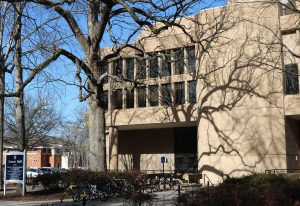
Lamar Hall is widely known for its spacious lecture halls, P.O.D. market and rather unappealing exterior. However, Lamar Hall exemplifies how outside appearance is not the only thing that matters.
Unlike the predominantly neoclassical-inspired architecture of most of the University of Mississippi’s campus, Lamar Hall (1977) embodies an architectural style consistent with brutalism. Brutalist architecture rejects an overtly decorative design. Rather, it is marked by its rough, bulky surfaces, abstract shapes and its reliance on concrete.
Nancy Wicker, a UM art history professor specializing in ancient and medieval art, thinks brutalism is too rough a term for the architectural style.
“I think the label ‘brutalism’ is unfortunate. It’s not about being ‘brutal’ but rather about allowing the exterior to reveal functional aspects of architecture, showing the use of the interior of the building instead of having an exterior that masks the interior,” Wicker said.
This is reflective of the wider discourse surrounding brutalism. It is often criticized for its utilitarian aesthetic and overall inhuman quality. However, advocates for this architecture emphasize its inherent functionality, robust structuring and its capacity for artistic expression.
Throughout campus, you’re more likely to encounter neoclassical buildings such as the Lyceum (1848), Bryant Hall (1911) and many of the sorority and fraternity houses. Neoclassicism has roots in ancient Greek and Roman architecture and is characterized by its imposing scale, stately columns and domed roofing.
There are severe and observable differences in the underlying ideas behind both neoclassicism and brutalism. Neoclassicism is primarily focused on the value of idealism, wherein architects rely upon classic design, making their structures in harmony with the design rules of antiquity.
Brutalism, though, emerged after WWII and remains heavily correlated with socialism. It was utilized by the Soviet Union and other socialist regimes due to its low cost and construction-efficient design. Mostly, brutalism emphasizes utility and simplicity – and a lot of raw concrete.
The neoclassical design, however, is steeped in undertones of white supremacy. This architecture is historically disconcerting to minority groups, as structures like these often exist in correlation with slavery. Neoclassical designs harken back to the facades of Southern plantation homes and the racist ideals of the Old South. UM’s own reliance upon slave labor in the early days of the school’s construction likely informed its decision to erect architecture that coincided with an enduring desire for whiteness and antiquity.
Freshman general business major Christian Cecil shared how the history of Lamar Hall has changed his opinion.
“At first glance, Lamar Hall is a bit of an eyesore,” Cecil said. “However, once you consider the history of neoclassicism, and its general racial impact, it definitely makes Lamar Hall’s ‘brutal’ exterior more appealing.”
Larmar Hall initially housed the university’s law school, and its brutalist design seemed to serve as a rejection of UM’s neoclassical foundation. The decision to construct the building for the study of law and justice in an architectural style that lacks this repressive history indicates a desire to create a new history that shuns racial inequity.
Freshman political science major Wendi Sheehan noted how Lamar Hall’s architectural style is inconsistent with the rest of the buildings on campus.
“Though its interior is inviting and practically designed, the exterior of Lamar Hall is a deviation from the norm of UM’s greater architectural design,” Sheehan said.
Many UM students share the same sentiment. While the outside of the building is not the most appealing, students appreciate what is on the building’s inside.
“I think it’s kind of ugly from the outside, but very modern within. I especially like the upper floors with all of the windows,” freshman accounting and economics major Olivia Mardis said. “The third floor has a little outdoor area by the writing center, and the fourth floor has the LGBTQ+ lounge that has a window of natural light that looks out over campus, so it’s really nice to sit in there.”
While some know Lamar Hall only for its brutalist exterior, its modern inside and historical context as a movement away from racism has put Lamar Hall in the hearts of many.


























